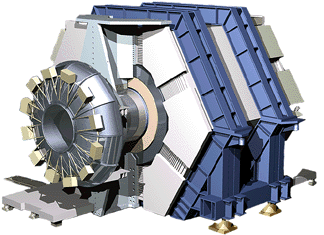|
|
|
BABAR
was a unique detector designed to exploit asymmetric e+e- collisions
at the SLAC B-meson factory located near Stanford University.
It operated between 1999 and 2008.
Until recently when analysis of first data from LHC started,
flavor physics of the third-generation particles,
bottom, top, and tau, could offer the best hope for discovery of New Physics,
because their large mass allows them to couple most effectively to undiscovered
physics. In particular, virtual ``loop'' transition of the bottom quark in the
B meson involves the heaviest presently known particles in the
FCNC loop and may reveal new particles in subtle effects.
The asymmetry between matter and antimatter is being
observed experimentally in the laboratory, but it appears to
be insufficient to account for the observed matter dominance
in our Universe.
|

|
Research Program on BABAR at JHU
This project was supported in part by the U.S. National Science Foundation (grant 0555519)
and Alfred P. Sloan Foundation. This project is mostly completed as of May 2009.
Group members
- Andrei Gritsan (PI of NSF grant 0555519)
- Zijin Guo (postdoctoral fellow, moved to CMS project)
- Yanyan Gao (graduate student, Ph.D. May 2009
[thesis],
moved to a postdoctoral position at Fermilab)
Recent Results
On the BABAR experiment we exploited the Heisenberg uncertainty principle every day.
We observe a virtual decay, also called a penguin loop, of a b-quark into the
about 50-times heavier t-quark and W-boson, which collapse quickly into lighter
quarks. This quantum trick allows us to produce the heaviest known elementary
particles for a short instant.
Read more in an article
"
Particles Spin Mysteriously through the BABAR Detector"
about our study of spin correlations in B meson decays.
Results presented at:
Fermi National Accelerator Laboratory seminar (April 2010)
[slides]
[
agenda]
Flavor Physics and CP conference in Slovenia (May 2007)
[
slides]
[
proceedings]
[
agenda]
Johns Hopkins Colloquium (March 2007)
[
slides]
DPF conference of US and Japan in Hawaii (November 2006)
[
slides]
[
agenda]
On the BABAR experiment we studied the phenomenon of "CP violation," Nature's preference of matter
over antimatter in the universe. We often illustrate this matter-antimatter
asymmetry with the
"Unitarity Triangle,"
a graphical representation of the fundamental processes that lead to CP violation.
A precise determination of the three angles (α, β, γ)
of this triangle was one of our primary goals.
Read more in an article
"
BABAR Tames the Mischievous Penguin"
about our study of the B->ρρ decays.
Results presented at:
34th International Conference on High Energy Physics (ICHEP 2008) (August 2008)
[slides]
[
agenda]
Fermi National Accelerator Laboratory seminar (December 2006)
[slides]
[
agenda]
Together with G. Kukartsev from UC Berkeley, we have also searched
for gluonic penguin B decays with excited eta and eta' mesons, such
as eta(1295), eta(1405), eta(1475), some of which are glueball candidates.
Most recent results have been published in
Physical Review Letters 101, 091801 (2008)
The JHU group has been investigating the B meson decays to particles
with spin, see an article for the Review of Particle Physics (2010)
"
Polarization in B Decays". The PI was involved in the BABAR
experiment from its early days in 1994 when he worked on BABAR
electromagnetic calorimeter R&D and developed BABAR drift
chamber wire tension techniques. Since 2000 he worked on
internal alignment of the Silicon Vertex Tracker, the core
of the tracking system. He served as a convener of the tracking
reconstruction group on BABAR. The JHU group continued support and
development of the BABAR Silicon Vertex Tracker local alignment
and tracking monitoring and was involved in other projects
supporting BABAR detector operation.
For recent technical contributions, see
Journal article on Silicon Detector Alignment:
[
Nucl. Instr. Methods Phys. Res. A 603, 467 (2009)],
[ preprint ]
1st LHC Alignment Workshop
[proceedings in CERN-2007-004]
[preprint]
|
|